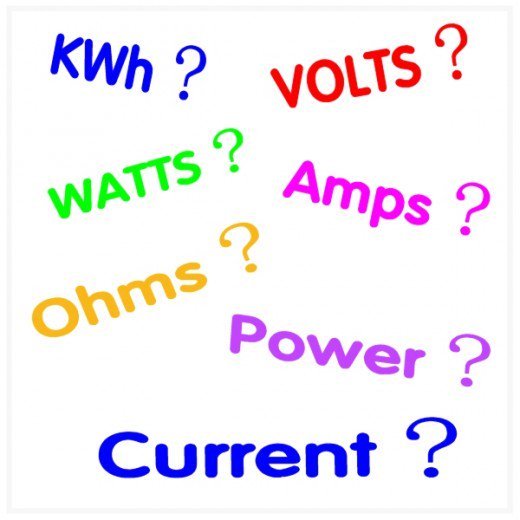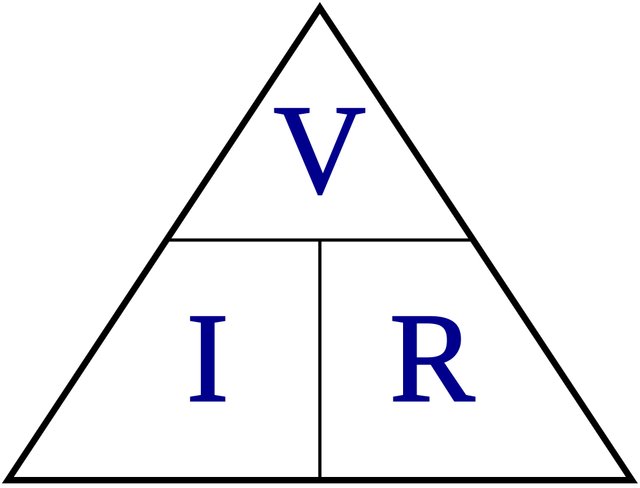Amps, Volts and Watts

So one of the most frequent misconceptions or at least misunderstandings we hear from our customers is how amps, volts and watts relate to each other in a solar system (or any system for that matter) and why more amps is not necessarily more power.
The quick mathematical formula which we’ve all heard of is E = I x R or V=I x R (Ohms law) where E (Electromotive force AKA Volts) = Amps (who’s symbol is “I”) x Resistance. Which boils down to: Volts = Amps * Resistance. Now I don’t want to concentrate on the formula too heavily except to give you a cheat on how to find out one value if you know the other two.

Above is the Ohms law triangle. To find any value, simply cover that value with your thumb and perform the math that remains by the other two values (either division or multiplication).
For example. If you want to know how much resistance there is in a wire (circuit) and you know the amperage and you know the voltage, then cover up the “R”, which leaves V / I (or V divided by I). To solve for volts, cover volts and you have I x R.
YEA Great, BUT WHAT DOES THIS MEAN?? What the heck is a WATT? and how is it different than an AMP.
OK, time for some electrical plumbing.
The goal is to fill a swimming pool with water. The swimming pool is our “Battery Bank”.
Now, were going to need some water (electrons) and were going to need a length of water hose for the electrons to flow through (wires).
Next we need some pressure from a pump (PSI) AKA electromotive force (volts) to push the water from our source (the solar panels) to the swimming pool (our battery bank). The more pressure we have the faster the water will flow (current will flow) through the hose. The rate of flow is current AKA amperage. The higher the rate of flow velocity (AMPS), the hotter things get, i.e. high amps, means high temperatures, not really a good thing, but I digress.
Now if we want the swimming pool to fill within a day or so we better have a pretty large hose (wire size) since we know a bigger hose has more capacity and using a small hose will certainly be very restrictive (think wire resistance).
But our budget is small and the hardware store does not have a large hose, it only has some garden hose. Hmm, we’ve got a problem, it’s going to be pretty tough to get all of the water moved from our source to the pool. We’ve got some choices that need to be made. We could increase the pressure (voltage) which will increase the total flow ( gallons per hour) or (watts per hour) or we could shorten the hose (to reduce the resistance), both might solve the problem.
Basically, if we increase the pressure (volts), we can reduce the hose size (wire size) and get the same result. (We’ve increased the voltage but ALSO increased the resistance), and got the same power– watts).
If we increase the hose size (reduce the resistance), we allow a greater current flow rate — AMPERAGE (AMP flow), and therefor can reduce the pressure (volts) and get the exact same result. (Remember ohms law — amps and volts are inversely proportional).
So what we are really after is accumulated flow (GPH) or in electrical terms we say POWER measured in watt hours or kilowatts per hour).
Volts and amps are the variables we can manipulate, but it’s all about accumulated power! We need to get this water flowing to fill up the pool. As long as we have flow we are accumulating water volume (power in the batteries.)
Now the longer the flow (at a useful rate) continues, the more volume or power we will have stored up in the reservoir.
We can measure this volume as GALLONS in the water world or AMP * HOURS or WATT * HOURS in the electrical world. If our battery has stored up 10 amp hours of power, it theoretically can power a load that consumes one amp at the battery voltage for one hour (or a 1/2 amp for two hours). We can just as easily express accumulated power as watt hours. So if our battery has gained 100 watt hours, it can power a 100 watt light bulb for one hour (or a 50 watt bulb for 2 hours). Watt hours is a measurement of total power whereas amp hours is a measurement of amp (flow) capacity at a certain voltage (in our case the battery voltage.)
For example, just as a gallon per hour is a measurement of the number of gallons moved in one hour, a watt hour is a measurement of how many watts of power were moved in an hour.
The restrictions due to hose size, pressure and the velocity of the water were all factors in determining how much water got into the pool by the time the day was done (the sun set).
- The bigger the wire, the easier it is to get more volume into the batteries.
- The higher the voltage of the system, the lower the rate of flow (current) can be in order to accomplish the same result.
- The smaller the wire, the higher the voltage should be or the amperage would have to be increased (to have the same power) which might cause the wire to heat up (and possibly overheat) and losses to accumulate.
Bigger wire, higher voltages and lower current is the most efficient system, yet budgets often dictate design not pure math, so use this new found knowledge as the design goal and then build safely with what you can afford.
Craig
Coleman Air, Inc.

Recent Comments